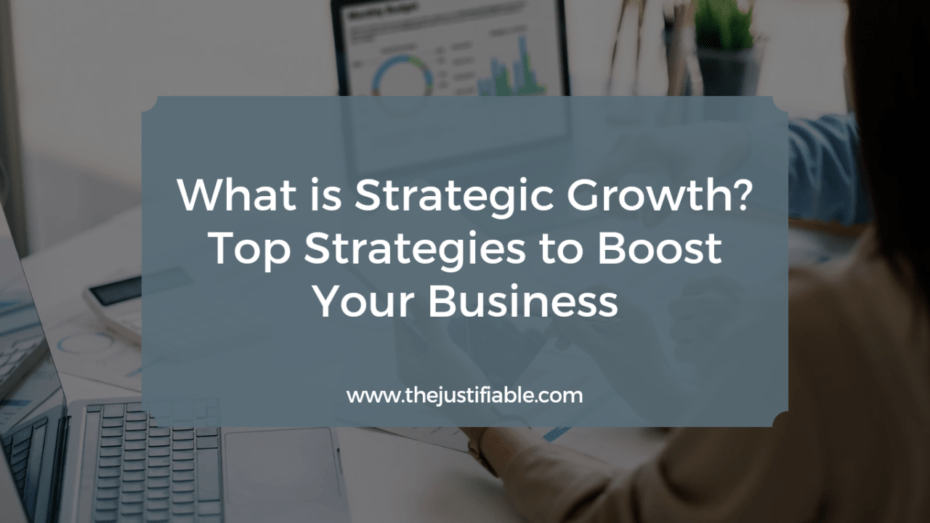Table of Contents
What is Strategic Growth? Every business begins with a seed of an idea, which, when nurtured carefully, can grow and flourish over time. However, to sustain this growth and ensure it remains in line with the ever-changing business landscape, it’s crucial to follow a strategic approach.
This introductory section will demystify the basics of business growth and offer a clear definition of strategic growth.
Understanding the Basics of Business Growth
Business growth is a stage where the business expands and enhances its operations, which is often marked by increased revenues, customer base, and market share. The growth phase of a business is more than just a numerical increase; it involves diversifying products or services, scaling the workforce, optimizing internal processes, and expanding geographically.
It’s a critical phase in the business lifecycle that signals the maturity and stability of an enterprise. However, growth can also pose various challenges. These can range from operational inefficiencies to resource allocation issues. It’s not uncommon for businesses to experience growing pains, such as cash flow problems or capacity constraints, as they expand.
To mitigate these issues and ensure sustainable growth, a strategic approach becomes necessary. This leads us to an important question, one that forms the central focus of this article: what is strategic growth?
Focus Keyword Definition: What is Strategic Growth?
Strategic growth is a methodical and deliberate approach to growing a business. It goes beyond the desire for quick, short-term expansion, focusing instead on long-term sustainability and success. Strategic growth involves careful planning, regular market and competitive analysis, efficient resource allocation, and a constant readiness to innovate and adapt.
At its core, strategic growth is about aligning business growth with overarching business goals and objectives. It’s about growing in a way that adds value not just to the company’s bottom line, but also to its customers, employees, stakeholders, and the industry it serves.
From increasing market share and improving profitability to enhancing brand reputation and fostering innovation, strategic growth can have several objectives.
The Importance of Strategic Growth in Business
Business growth is often a sign of a company’s success. However, not all growth is created equal. The methods used to achieve it and the sustainability of the growth achieved are crucial factors in determining long-term business success.
This section will explore the importance of strategic growth by contrasting it with organic growth and discussing its role in sustainable business success.
Strategic Growth vs. Organic Growth
When discussing business expansion, two types of growth often come up: organic growth and strategic growth. But what distinguishes these two, and why does it matter? Organic growth refers to the natural progression of a business over time.
This growth is achieved through internal processes, such as increasing customer base, boosting sales, or expanding the range of products or services offered. While organic growth is generally slow and steady, it is also perceived as low risk because it doesn’t involve significant changes to the business model or structure.
On the other hand, strategic growth is a more proactive and deliberate approach to expansion. It involves identifying and implementing specific strategies aimed at achieving set business objectives.
This may include measures such as mergers and acquisitions, partnerships, exploring new markets, or investing in innovative technologies. Strategic growth is generally faster and can result in substantial growth spurts, but it also involves a higher level of risk and requires careful planning and execution.
While both organic and strategic growth have their merits, the strategic approach provides an opportunity for businesses to take control of their growth trajectory. Instead of waiting for growth to happen, businesses can actively create opportunities and leverage them for expansion.
The Role of Strategic Growth in Sustainable Business Success
So, why is strategic growth crucial to sustainable business success? Let’s explore this further.
Firstly, strategic growth helps businesses to maintain a competitive edge. In today’s dynamic business environment, standing still is not an option. Businesses need to continually evolve and adapt to stay ahead of their competition. Strategic growth allows businesses to anticipate changes in the market, capitalize on new opportunities, and navigate challenges effectively.
Secondly, strategic growth contributes to the long-term stability of a business. By aligning growth strategies with the overall business objectives, companies can ensure that their expansion efforts support and enhance their long-term vision and mission. This helps prevent short-termism, a focus on immediate gains at the expense of long-term sustainability, which can lead to issues like over-expansion or resource misallocation.
Lastly, strategic growth promotes innovation and resilience. By continually seeking and implementing strategic growth opportunities, businesses can foster a culture of innovation. This not only leads to the development of new products and services but also encourages the business to become more resilient, adaptable, and ready to tackle future challenges.
Elements of Strategic Growth
Strategic growth is not an abstract concept; it’s a process that involves a series of concrete steps and key elements. It’s essential to understand these elements to appreciate what strategic growth entails and how it can be effectively implemented.
In this section, we’ll explore three fundamental elements of strategic growth: defining business goals and objectives, market and competition analysis, and resource allocation and management.
Defining Business Goals and Objectives
Before you can begin your journey of strategic growth, you must know where you want to go. That’s where business goals and objectives come in. Defining clear, measurable, and attainable goals is the first step in strategic growth planning.
These goals could pertain to various aspects of your business, such as revenue, market share, customer satisfaction, employee engagement, or social impact. Your business goals should reflect your company’s mission and vision, serving as a roadmap to guide your growth strategies.
They should be specific enough to provide a clear direction, yet flexible enough to allow for adjustments as market conditions change. It’s also essential to break down larger goals into smaller, more manageable objectives. This makes your goals seem less daunting and allows for easier tracking of progress.
Market and Competition Analysis
Understanding the market you operate in and the competition you face is another critical element of strategic growth. Market analysis involves examining factors like market size, trends, customer behaviors, and demand patterns. It provides valuable insights into where opportunities lie and how these can be leveraged for growth.
Similarly, competition analysis helps you understand who your competitors are, what they offer, and how they operate. This knowledge can help you identify gaps in the market that your business could fill, differentiate your products or services, or find ways to outperform your competition.
Both market and competition analysis should be ongoing processes, not one-time activities. Markets and competition are dynamic, and regular analysis can help you stay ahead of changes and adapt your strategies as needed.
Resource Allocation and Management
Effective resource allocation and management are also essential for strategic growth. Resources here refer not just to financial resources, but also to human resources, physical assets, technology, and time. Efficient resource allocation ensures that you’re investing in the right areas to achieve your growth objectives.
Resource management also involves making the most of the resources you have. This could mean improving operational efficiency, enhancing employee productivity, or optimizing your supply chain. By managing resources effectively, you can minimize waste, reduce costs, and boost your overall performance, contributing to sustainable growth.
Top Strategies to Boost Your Business through Strategic Growth
In order to drive strategic growth, businesses need to implement strategies that are not only aligned with their objectives but also adapt to the dynamic market environment. Let’s delve into some top strategies that can guide your business towards strategic growth.
Developing a Strong Value Proposition
A value proposition is a unique blend of products, services, and brand attributes that sets your business apart from the competition. It articulates why customers should choose your offerings over others in the marketplace. The stronger your value proposition, the more likely you are to attract and retain customers, which is vital for business growth.
Developing a strong value proposition requires a deep understanding of your target audience, their needs, and how your offerings can address those needs better than the alternatives. It involves continuously innovating and improving your products or services to deliver superior value. Remember, a strong value proposition is not static; it evolves with changing customer needs and market dynamics.
Exploring New Markets
One of the most effective ways to accelerate business growth is by exploring new markets. This could involve geographical expansion into new regions or countries, or entering new segments within your existing market.
By expanding your market, you can reach more potential customers and diversify your revenue streams, reducing the risk associated with relying on a single market. Entering a new market requires careful planning and research.
You need to understand the market’s dynamics, customer behaviors, regulatory environment, and competition. You may also need to adapt your products, services, or marketing strategies to suit the new market. This is where strategic planning comes in, helping you navigate the complexities of market expansion and seize growth opportunities.
Investing in Technology and Innovation
In today’s digital age, technology and innovation are key drivers of strategic growth. By investing in new technologies, businesses can improve their efficiency, enhance their offerings, and create a competitive edge.
Whether it’s through advanced data analytics, artificial intelligence, automation, or digital marketing, technology can open up a world of opportunities for business growth. Innovation goes hand in hand with technology.
It involves constantly seeking and implementing new ideas, whether for products, services, processes, or business models. An innovative mindset can help businesses stay ahead of the curve, adapt to changing market conditions, and achieve sustainable growth.
Case Studies of Successful Strategic Growth
Sometimes, the best way to understand strategic growth is to observe it in action. Here, we present two case studies of renowned companies that have successfully used strategic growth strategies to boost their businesses – Amazon and Tesla.
Case Study 1: Amazon – Leveraging Technology for Strategic Growth
Amazon is a classic example of a company that has used technology as a primary driver of its strategic growth. Founded as an online bookstore, Amazon quickly realized the potential of the internet as a platform for retail and began to expand its product range.
Today, Amazon is the world’s largest online retailer and has diversified into cloud services, streaming entertainment, and even physical stores. A significant element of Amazon’s strategic growth has been its use of technology to enhance customer experience.
From personalized product recommendations to one-click purchasing and ultra-fast delivery services, Amazon uses technology at every step to make shopping more convenient for its customers. This strong focus on customer-centric innovation has allowed Amazon to continually grow and stay ahead of its competition.
Case Study 2: Tesla – Embracing Innovation and Market Disruption
Tesla is another company that has harnessed strategic growth to revolutionize its industry. Tesla entered the automotive market with a clear mission: to accelerate the world’s transition to sustainable energy.
Instead of going head-to-head with established automakers, Tesla chose to disrupt the market by focusing on electric vehicles. Tesla’s strategic growth strategy has involved continuous innovation, particularly in terms of technology and product design.
From developing high-performance electric powertrains to introducing self-driving features, Tesla has continually pushed the boundaries of what’s possible in the automotive industry. Despite facing skepticism and resistance, Tesla’s commitment to its strategic growth objectives has allowed it to become a leader in the electric vehicle market.
In both these examples, Amazon and Tesla have displayed a strong commitment to their strategic growth objectives. They have harnessed technology and innovation, differentiated themselves from the competition, and continually adapted to changing market conditions. Their success underlines the power of strategic growth and offers valuable lessons for other businesses.
Challenges and Solutions in Strategic Growth
While strategic growth offers numerous benefits, it’s not without its challenges. Recognizing these challenges and preparing for them is a crucial part of the strategic growth journey.
In this section, we’ll discuss some common challenges that businesses might face when pursuing strategic growth and suggest ways to overcome them.
Challenge 1: Balancing Short-term Needs with Long-term Goals
One common challenge in strategic growth is balancing the immediate needs of the business with its long-term growth objectives. Short-term pressures, such as quarterly earnings targets or immediate cash flow concerns, can sometimes overshadow long-term strategic growth initiatives.
Solution
To overcome this challenge, it’s important to maintain a clear focus on your strategic growth objectives and not allow short-term pressures to derail your long-term plans. This requires strong leadership and effective communication to ensure that all stakeholders understand and support the long-term vision of the business.
In addition, incorporating a range of short, medium, and long-term objectives into your strategic growth plan can help balance the immediate needs with the future goals of the business.
Challenge 2: Adapting to Market Changes
Another challenge in strategic growth is adapting to changes in the market. Market conditions can change rapidly due to factors like technological advancements, changes in customer behaviors, regulatory changes, or competitive actions. These changes can disrupt your strategic growth plans and make it harder to achieve your growth objectives.
Solution
Regular market and competition analysis can help you stay abreast of changes and adapt your strategies as needed. It’s also important to foster a flexible and adaptable organizational culture that can quickly respond to changes. In addition, investing in market research and business intelligence tools can provide valuable insights into market trends and help you anticipate changes.
Challenge 3: Managing Resource Constraints
Resource constraints are another common challenge in strategic growth. As businesses grow, they often need additional resources – such as capital, employees, technology, or physical assets – to support their expansion. However, acquiring and managing these resources can be challenging, particularly for small and medium-sized businesses.
Solution
Effective resource management can help overcome this challenge. This involves careful planning to ensure that resources are allocated in line with strategic growth objectives. It also involves continuously optimizing operational efficiency to make the most of available resources. In addition, seeking external funding or forming strategic partnerships can help secure the necessary resources for growth.
In conclusion, while strategic growth comes with challenges, these can be overcome with careful planning, flexibility, and effective resource management. By recognizing and preparing for these challenges, businesses can ensure that their strategic growth journey is successful and sustainable.
Conclusion
Strategic growth is an essential component of business success. By understanding the concept of strategic growth and its importance, businesses can take an active role in shaping their growth journey and securing their long-term sustainability.
Recap of Strategic Growth
Strategic growth involves setting clear business goals, understanding the market and competition, and effectively allocating resources. It’s about actively creating and leveraging opportunities for expansion, rather than waiting for growth to happen naturally.
Some of the top strategies for strategic growth include developing a strong value proposition, exploring new markets, and investing in technology and innovation. These strategies can help businesses differentiate themselves, reach more customers, and stay ahead of the curve.
However, strategic growth is not without its challenges. Balancing short-term needs with long-term goals, adapting to market changes, and managing resource constraints are common hurdles. By recognizing and preparing for these challenges, businesses can enhance their chances of achieving successful and sustainable growth.
Final Thoughts on Strategic Growth
In conclusion, strategic growth is a powerful tool for businesses seeking to boost their performance, increase their market share, and secure their future success. The examples of companies like Amazon and Tesla show the potential of strategic growth when executed effectively.
Remember, strategic growth is a journey, not a destination. It requires ongoing effort, adaptability, and a commitment to long-term success. So, as you embark on your strategic growth journey, keep in mind the insights shared in this article and adapt them to your unique business context.
Whether you’re a small startup or a large corporation, strategic growth can open up new possibilities and opportunities. So, take the time to understand it, embrace it, and let it guide your business towards a brighter and more prosperous future.






